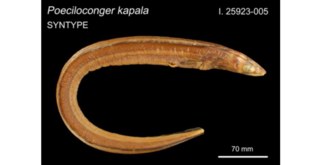
The Eel River is a 94-mile-long (151 km) tributary of the Wabash River in northern Indiana in the United States. Via the Wabash and Ohio rivers, its waters flow to the Mississippi River and ultimately the Gulf of Mexico. The Eel River rises southeast of Huntertown in Allen County and flows southwest through Allen, Whitley, Kosciusko, Wabash, Miami, and Cass counties to join the Wabash at Logansport. The river was called Kineepikwameekwa Siipiiwi - "river of the snake fish" by the Miami people, who inhabited the area at the time of European contact, the English rendered it as Ke-na-po-co-mo-co. It is the northern of the two rivers named Eel River within Indiana.

The Congridae are the family of conger and garden eels. Congers are valuable and often large food fishes, while garden eels live in colonies, all protruding from the sea floor after the manner of plants in a garden. The family includes over 220 species in 32 genera.

Ophichthidae is a family of fish in the order Anguilliformes, commonly known as the snake eels. The term "Ophichthidae" comes from Greek ophis ("serpent") and ichthys ("fish"). Snake eels are also burrowing eels. They are named for their physical appearance, as they have long, cylindrical, snake-like bodies. This family is found worldwide in tropical to warm temperate waters. They inhabit a wide range of habitats, from coastal shallows and even rivers, to depths below 800 m (2,600 ft). Most species are bottom dwellers, hiding in mud or sand to capture their prey of crustaceans and small fish, but some are pelagic.
Henry Weed Fowler was an American zoologist born in Holmesburg, Pennsylvania.

Ariosoma is a genus of marine congrid eels.
Notacanthus is a genus of spiny eels in the family Notacanthidae.
Bathycongrus is a genus of eels in the family Congridae.

Bathyuroconger is a genus of eels in the family Congridae. It currently contains the following species:
Macrocephenchelys is a genus of eels in the family Congridae.

The Congrinae are a subfamily of eels in the family Congridae.

Ophidion is a genus of cusk-eels.
Parabathymyrus brachyrhynchus is an eel in the family Congridae. It was described by Henry Weed Fowler in 1934, originally under the genus Ariosoma. It is a marine, deep water-dwelling eel which is known from the western central Pacific Ocean. It dwells at a maximum depth of 289 metres. Males can reach a maximum total length of 33 centimetres.
Bathycongrus bleekeri is an eel in the family Congridae. It was described by Henry Weed Fowler in 1934. It is a tropical, marine eel which is known from the Philippines, in the western central Pacific Ocean. It is known to dwell at a depth of 51 metres. Males can reach a maximum total length of 8 centimetres.
The Toothy conger is an eel in the family Congridae. It was described by Henry Weed Fowler in 1934, originally under the genus Uranoconger. It is a marine, deep water-dwelling eel which is known from the western Indian and southwestern Pacific Ocean, including the Philippines and Indonesia. It is known to dwell at a depth of 886 metres. Males can reach a maximum total length of 4.3 centimetres.
Bathyuroconger parvibranchialis is an eel in the family Congridae. It was described by Henry Weed Fowler in 1934, originally under the genus Silvesterina. It is a marine, deep water-dwelling eel which is known from the western central Pacific Ocean. It is known to dwell at a depth of 1023 metres.
The Rubbernose conger is an eel in the family Congridae. It was described by Johnson T. F. Chen and Herman Ting-Chen Weng in 1967, originally under the genus Rhynchoconger. It is a marine, tropical eel which is known from the western Pacific Ocean, including Taiwan and Australia. It dwells at a depth range of 280 to 440 metres. Males can reach a maximum total length of 36.7 centimetres (1.20 ft).
Benthenchelys cartieri is an eel in the family Ophichthidae. It was described by Henry Weed Fowler in 1934. It is a tropical, marine eel known from the Philippines, in the western central Pacific Ocean. It is known to dwell at a maximum depth of 1168 m, and inhabits the pelagic zone.
Muraenichthys elerae is an eel in the family Ophichthidae. It was described by Henry Weed Fowler in 1934. It is a marine, tropical eel which is known from the Philippines, in the western central Pacific Ocean.
The Fringe-lipped worm-eel is an eel in the family Ophichthidae. It was described by Henry Weed Fowler in 1934. It is a marine, tropical eel which is known from the western central Pacific Ocean, including Taratara Island, Samar Island, the Philippines, the Marshall Islands, Micronesia and Solomon Island. It dwells at a maximum depth of 48 metres (157 ft), and inhabits benthic sand sediments in coral reefs. Males can reach a maximum total length of 11.5 centimetres (4.5 in).

Ariosoma kapala is an eel in the family Congridae. It was first described in 1990 by Peter H. J. Castle as Poeciloconger kapala. The holotype was collected by the New South Wales Fisheries Research Vessel Kapala on April 11, 1985, during a bottom trawl at a depth of 46–64 m. The species was named for the FRV Kapala. In 1998, Shieh-Chieh Shen moved the species to the genus Ariosoma.







